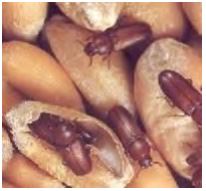Use of biocontrol fungi, bacteria and nematodes for control of Tribolium confusum and other stored grain pests.
Principle Investigator: Dr. Gadi V.P. Reddy
Co-investigators: Dr. Brian Thompson, Dr. Stefan Jironski, Daniel E. Picard, Debra A. Miller
Western Triangle Agricultural Research Center, Montana State University, 9546 Old Shelby Rd.,
P.O. Box 656, Conrad, MT 59425, USA
Objective:
Investigate the usefulness of entomopathogenic fungi (Beauvaria bassiana and Metarhizium brunneum), entomopathogenic bacteria (e.g. Spinosad) and entomogenous nematodes (Steinernema carpocapsae, Heterorhabditis bacteriophora Steinernema feltiae, H. bacteriophora and H. indica) for the control of stored grain pests.
Background:
Stored grain pests are a significant post-harvest threat for grain producers. Insects that feed on small grains in storage decrease the value of the crop going to market and may delay shipment of grains. Hydrogen phosphide is the current preferred method for the control of stored grain pests, but is highly toxic to mammals, posing a significant risk to applicators and anyone or anything it contacts. Diatomaceous earth is a non-toxic alternative, but careful use is needed to prevent devaluing of the grain at time of sale as Diatomaceous earth wears on milling machinery and is not tolerated in high quantities in grain. Alternative tools for control of stored grain pests that are not dangerous and do not devalue grain are needed to address the stored grain pest issue without the negatives offered by current methods. This ongoing study looks at the use of entomopathogenic fungi (Beauvaria bassiana and Metarhizium brunneum), bacteria and entomogenous nematodes (Steinernema carpocapsae, Heterorhabditis bacteriophora Steinernema feltiae, H. bacteriophora and H. indica) for the control of stored grain pests. The most prominent local stored grain pest is the confused flour beetle Tribolium confusum. This research will look at T. confusum and other stored grain pests under biological control paradigms. A body of literature suggests entomopathogenic fungi alone and in combination with diatomaceous earth are effective in controlling flour beetle populations and may even stimulate avoidance of recolonization. This research will expand on this previous literature and in the process develop another tool for controlling stored grain pests in Montana.
Methods:
Tribolium confusum was collected from local storage bins and purchased as intact colonies from Carolina Biological Supply Company, Burlington, NC. Flour beetle colonies will be set up in plastic Rubbermaid 6.15L containers (33.7 ×21.6×11.9cm). Each container will contain a combination of intact wheat seed and flour in an attempt to replicate conditions in storage bins. Fifty adult T. confusum will be placed in each storage container and allowed one week to establish prior to application of biocontrol fungi. The commercially available strain of B. bassiana, Botaniguard (Laverlam Inc) will be tested against a no-treatment control population for overall mortality and persistence in reducing flour beetle populations. Other biocontrol agents will be tested in a similar manner.
Colony members will be sorted and counted for larvae and adults in the colony prior to the application of biocontrol agents and every 24hrs after application for up to 30 days post application. Percent mortality will be tabulated and analyzed using sigma plot statistical software (Systat).
WTARC will test avoidance of fungal and nematode treated wheat seed using our recently acquired olfactometer (Figure 2).
Results:
This project is ongoing. No results to report at this time. Colonies were initated into the trial on December 22nd 2014. Earliest results will return in January of 2015.
Discussion:
Pending results.
Acknowledgements
Funding for this research was initially provided by U.S. Department of Agriculture-National Institute of Food and Agriculture (USDA-NIFA) Hatch (#MONB00859).
Figure 1. The confused flower beetle (Tribolium confusum) on wheat seed.
Figure 2. Olfactometer with decision chamber and collection ports installed. Air leaves through the hole in the center and is pumped in through the collection ports. The test insect follows attractants to their source and is collected in the glass collection chamber.


